Freaks, Oddities, Quirks of Nature
Oyster Growing on a Set of False Teeth
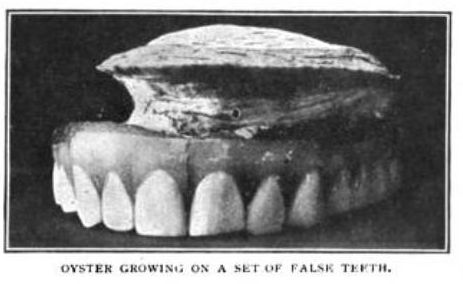
image source: The Strand magazine - 1903
Oysters will grow on almost any surface, including false teeth, if that's what happens to be available. The tooth-growing oyster shown above was found in the Chesapeake Bay in 1898, and sent to the Smithsonian where they were put on display and became quite a popular attraction. But soon a paternity battle erupted around them. The story was told in the Saint Paul Globe (Nov 30, 1902):
And, oddest of all, there is an upper set of false teeth to which an enterprising oyster is firmly attached.
The history of this last oyster is decidedly interesting. About four years ago it was raked out of the waters of Chesapeake bay by a dredging boat, together with the false teeth to which it was firmly fixed, and teeth and oyster were acquired by a hotel keeper at Cowart, Va., whose wife forwarded them to the Smithsonian Institution at Washington. The matter obtaining some advertisement, a man named Webster, residing in Bedford, Iowa, claimed the teeth, saying that he had lost them from a steamer bound for Norfolk.
The Smithsonian officials were undecided at first as to whether they should surrender the teeth or not, the object being so great a curiosity that they were anxious to hold on to it. But not many days later a Philadelphia woman claimed them, asserting that they were hers, and actually a third party, visiting the institution, demanded them, declaring that he recognized them as having been lost by himself.
Probably, from first to last, a good many persons have lost their false teeth overboard in the Chesapeake, the waters of which are liable to be pretty rough at times. Any way, the government scientists did not care to decide the dispute, and concluded to retain the specimen.
Half a century later, in 1954, yet another guy insisted the teeth were his, but in this case the Smithsonian was able to definitively rule out his claim, pointing out that the guy hadn't even been born yet when the teeth were found.
I'm guessing the Smithsonian probably still has this tooth-growing oyster hidden away somewhere in its archives.
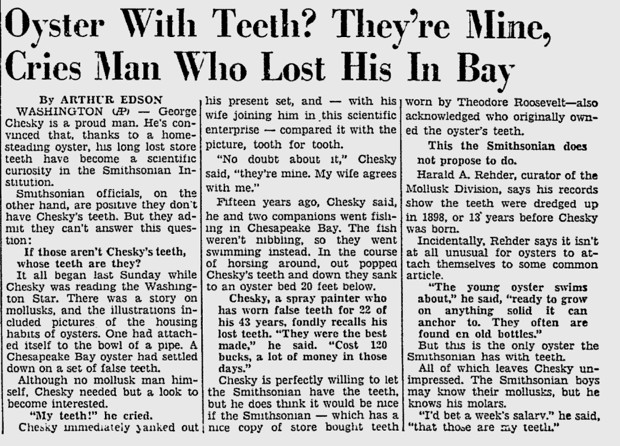
Daytona Beach Morning Journal - Jan 28, 1954
Posted By: Alex - Mon Nov 26, 2012 -
Comments (3)
Category: Freaks, Oddities, Quirks of Nature, Museums, Oceans and Maritime Pursuits, Natural Wonders
Big Mouth Dentist

The dental patient depicted was a favorite at dental training college for his easy access.
Original ad here.
Posted By: Paul - Wed Nov 21, 2012 -
Comments (7)
Category: Freaks, Oddities, Quirks of Nature, 1920s, Face and Facial Expressions
An Icicle That Looks Like A Bird

It must have been a slow news day when this photo ran in papers back in 1959. The icicle that looks like a bird was found outside a Detroit home.
Posted By: Alex - Fri Oct 19, 2012 -
Comments (4)
Category: Freaks, Oddities, Quirks of Nature, Nature, Weather, 1950s
More Giants!
Pitiless beautiful-people giants stalk and dominate mere mortals, making our helpless planet and civilization their careless playground.
And that makes me want to use your airline?
Alex is on to something here!
Posted By: Paul - Sat Sep 29, 2012 -
Comments (6)
Category: Business, Advertising, Giant People in Ads, Freaks, Oddities, Quirks of Nature, Air Travel and Airlines, Asia, Fictional Monsters
How the Marsh Mongoose catches prey
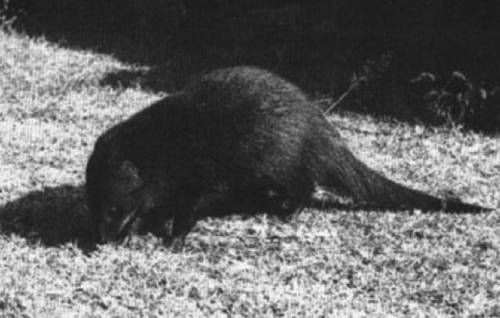
The Marsh Mongoose (Atilax paludinosus), also known as the African Water Mongoose, has an unusual method of catching its favorite food (birds). It makes its butt look like a piece of ripe fruit, which tempts birds over to investigate — and fall right into its trap. Jonathan Kingdon, author of East African Mammals, explains:
According to Animal Diversity Web, the Marsh Mongoose also has another odd trick:
Goes to show that you really can't compete with Nature for weirdness.
Posted By: Alex - Sun Sep 16, 2012 -
Comments (5)
Category: Animals, Freaks, Oddities, Quirks of Nature, Science
The Great Antonio
The strongman Antonio Barichievich (1925-2003), aka the Great Antonio, seems Weird-Universe worthy. Here's a few brief facts about his life (via wikipedia and mrkurtnielsen.com):- He first made it into the Guinness Book of World Records in 1952 by pulling a 433-ton train 19.8 metres.
- He weighed 465 pounds (at his heaviest) and stood about 6 foot 4 inches.
- He could eat 25 chickens or 10 steaks at one sitting.
- He claimed that he trained by running head-on into trees from a distance of 60 metres.
- He sang with a soft, beautiful voice, and at one time wanted to tour with Tiny Tim.
- He owned what was possibly the world's largest rocking chair — 4 meters high and 2 meters wide.
- He believed he was descended from extraterrestrials.
- As he grew older, he braided his dreadlocks into a club held together with masking tape and used this to play "hair golf."
- Later in life, the only way to contact him was to leave a message at the Dunkin' Donuts in Rosemont, Canada.
- He died of a heart attack at the age of 77.


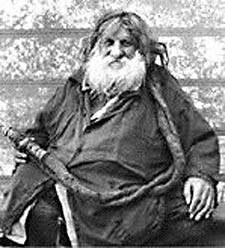

Posted By: Alex - Tue Sep 11, 2012 -
Comments (4)
Category: Eccentrics, Freaks, Oddities, Quirks of Nature, Human Marvels
Wallace Rossall, the “Upside Down Boy”
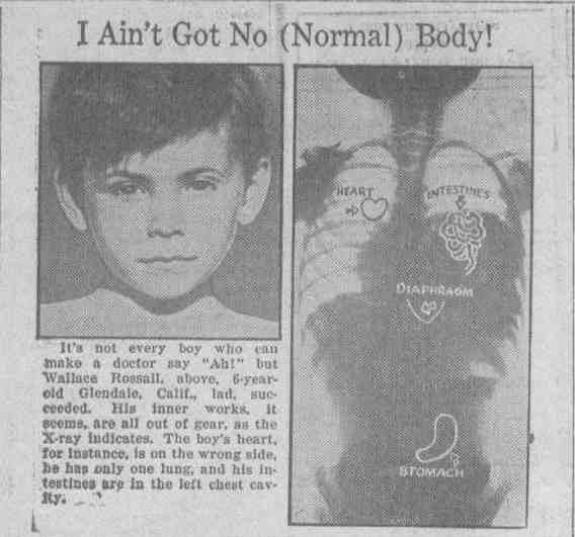

[Click to enlarge]

Poor Wallace Rossall. With his "twisted insides" he was obviously doomed to an early death.
But maybe not!
If this death record pertains to our Wallace--correct birth date; still living in California at time of death--then he lived to the decent age of 65 or 66.
Posted By: Paul - Thu Aug 16, 2012 -
Comments (10)
Category: Body, Diseases, Stomach, Freaks, Oddities, Quirks of Nature, 1930s
For Your Height Only
Learn more here.
Posted By: Paul - Mon Jul 09, 2012 -
Comments (3)
Category: Beauty, Ugliness and Other Aesthetic Issues, Freaks, Oddities, Quirks of Nature, Movies, Spies and Secret Agents, 1980s, South Pacific
Giant Pants on a Giant
From a blog devoted exclusively to Giant Pants of the '30s.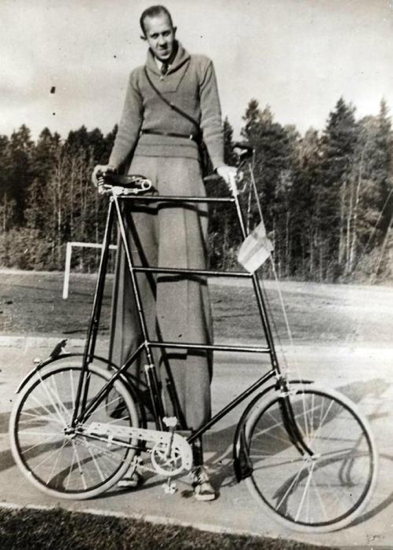
(via Sloth Unleashed)
Posted By: Alex - Tue Jan 31, 2012 -
Comments (2)
Category: Fashion, Freaks, Oddities, Quirks of Nature
Weird Universe Cruise
It's official. Weird Universe will be hosting its first cruise, departing on August 12 from Fort Lauderdale and returning on the 19th. We'll be sailing aboard the spectacular ship the Allure of the Seas, and accompanying us onboard will be celebrity mother Kate Gosselin and her fans, allowing WUvies to study weirdness at first hand, up close and personal! Reservations are now being taken. Book your cabin at kategosselincruise.com.
Posted By: Alex - Fri Jan 13, 2012 -
Comments (5)
Category: Celebrities, Freaks, Oddities, Quirks of Nature, Travel, Surrealism

| Who We Are |
|---|
| Alex Boese Alex is the creator and curator of the Museum of Hoaxes. He's also the author of various weird, non-fiction, science-themed books such as Elephants on Acid and Psychedelic Apes. Paul Di Filippo Paul has been paid to put weird ideas into fictional form for over thirty years, in his career as a noted science fiction writer. He has recently begun blogging on many curious topics with three fellow writers at The Inferior 4+1. Contact Us |




